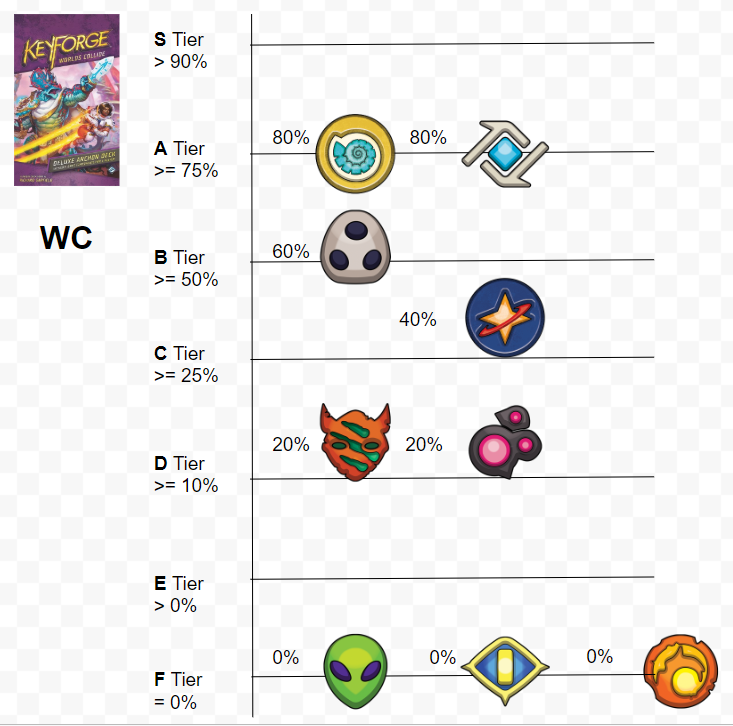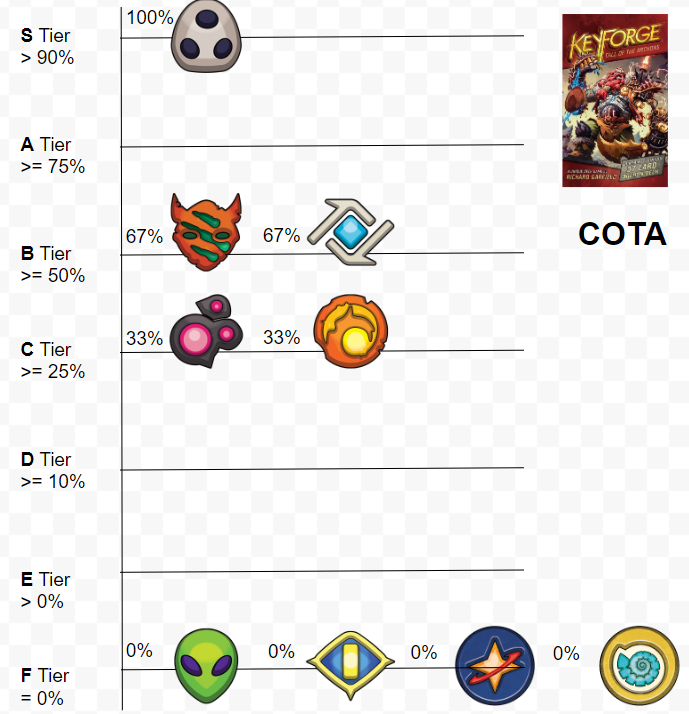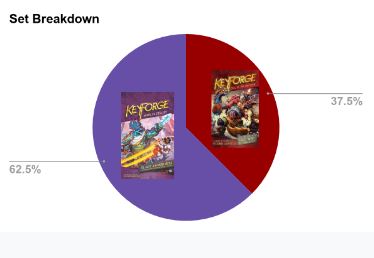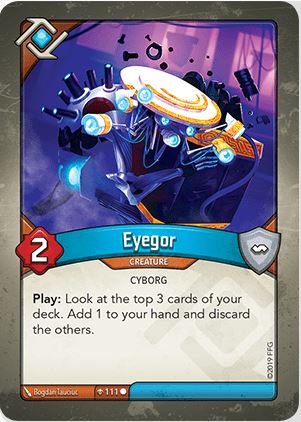

PAX Unplugged Archon Vault Tour
Have you ever wondered which decks are good enough to compete at the highest level? My goal is to address this by answering the following questions for you:
- How powerful is each house in the current meta?
- How powerful is each set in the current meta?
- What are the top cards to look for in a successful deck?
- How high of a SAS and/or AERC rating is required for a deck to be considered elite?
- What is the AERC profile of an elite deck?
- Which deck archetype(s) are currently playable at the highest level?
- How do I identify an elite deck?
This analysis is all based on the top cut decks from the archon format at PAX Unplugged Vault Tour on December 6-7, 2019.

https://archonarcana.com/2019_PAX_Unplugged_Archon_Vault_Tour
This vault tour was smaller than most, so the top cut was just 8 decks rather than the typical 16. Special thanks to Lady Caffeina for gathering the data from the vault tour.
TL:DR – Scroll to the very bottom for the summarized profile of an elite deck.
- How powerful is each house in the current meta?


To try to answer the question of how powerful each house is in the current meta, I looked at the percent representation of each house in the top cut at the vault tour. The criteria I decided upon for each tier is:
- S tier > 90%
- A tier >= 75%
- B tier >= 50%
- C tier >= 25%
- D tier >= 10%
- E tier > 0%
- F tier = 0%
In the screenshots above, we can see that Shadows is the only house in the S tier for COTA, though it is in the B tier for WC. Shadow’s dominance has been evident since COTA was first released with the sheer number and power of steal effects.
COTA has no decks in the A tier, but WC has 2: Logos and Saurian. These houses have some of the strongest cards in the set, many of which are at the common slot.
For the B tier, COTA has 2: untamed and Logos. The untamed cards are typically burst oriented and the logos cards are typically oriented toward cycling through your deck. WC has 1 B tier house: Shadows. This is somewhat surprising due to popular believe that Shadows has become weak, but this may be bias due to its fall from dominance in COTA and AoA.
The C tier contains 1 WC house: Star Alliance. I think this will turn out to be too low of a rating due to all of the house cheating and key control, but we are working with a very small sample size. Dis and Brobnar are both in the C tier for COTA, but I think Dis is too low and Brobnar is too high, again due to a small sample size.
The D tier is reserved for WC this time, with both Untamed and Dis. Untamed seems bursty, but less so than in COTA. Dis seems to have some powerful purge and aember control effects, and I think it is currently rated too low.
There are no houses in Tier E, but Mars and Sanctum both have 0% usage in both sets. These two houses are phased out of WC completely, and were typically considered mediocre in COTA. Star Alliance and Saurian did not yet exist when COTA came out, so they are also at 0% usage.
2. How powerful is each set in the current meta?

https://cf.geekdo-images.com/opengraph/img/tPQAqYd4QfI0AW5Mb1wK36fuB_E=/fit-in/1200×630/pic5054769.jpg
To try to answer this question, I looked at representation of sets among the top cut at this vault tour. Among the top 8 decks at PAX, 5 were WC and 3 were COTA, a break down of 62.5% WC to 37.5% COTA. This is a fairly even split that slightly favors WC, perhaps due in part to the fact that it is the first vault tour where WC was legal to play. The general consensus seems to be that WC and COTA are fairly equal in strength. We can clearly see that AoA is weaker, as it was not represented at all in the top 8.
3.What are the top cards to look for in a successful deck?
I looked at the most commonly occurring cards in the top 8 decks, separated by set, to help us target which cards to look for in a successful deck. Now, it is important to realize that there is some bias here because not all cards have the same rarity. Therefore, a card that is common within a highly-represented house is more likely to show up for this reason than a rare card, even if it is not necessarily a strong card. It is also worth noting that 8 decks is a relatively small sample size when looking at something like individual cards from such a large pool of possibilities. My impression though is that when trying to analyze if a deck can be successful, keep an eye out for as many of these cards as possible. With this in mind, I present the most common cards in the top 8:
WC Card Usage:

https://decksofkeyforge.com/cards?aercHistoryDate=&sort=SET_NUMBER&title=eyegor
- Eyegor: 6
- Tautau Vapors: 5
- Ronnie Wristclocks: 5
- J. Vinda: 4
- Tribute: 4
- Phalanx Strike: 4
- Thorium Plasmate: 3, Cutthroat Research: 3, Too Much to Protect: 3, Legatus Raptor: 3, Questor Jarta: 3, Senator Shrix: 3, Hock: 3, Wormhole Technician: 3
COTA Card Usage:

https://decksofkeyforge.com/cards?aercHistoryDate=&sort=SET_NUMBER&title=mother
- Mother: 5
- Nerve Blast: 4
- Ghostly Hand: 3, Umbra: 3, Hunting Witch: 3, Bumpsy: 3, Wild wormhole: 3
WC Reaction:
- I’m not too surprised to see that all of the cards that occur 3 times or more in the top 8 decks are from the top 3 highest usage houses: Logos, Shadows, and Saurian. Eyegor and Tautau Vapors, both commons, are excellent for cycling through your deck, something that Logos particularly excels at in WC. Ronnie Wristclocks has been famously strong since AoA first came out, and it makes sense that Too Much to Protect would be on the list of one of the only large aember swing cards available post Bait and Switch errata. For Saurian, we see Tribute, perhaps their strongest card in the set, allowing you to gain and aember and potentially capture 4 at once. This can be combo’d with a number of Saurian cards to either gain the aember yourself or make it go to the common supply when the creature with this horde of aember is killed.
COTA Reaction:
- Mother comes in at the top of the list and this makes a lot of sense. This is an elite card that your opponent has to deal with in a hurry or give you a large draw advantage over time. Nerve blast is another excellent card, almost always proc’ing since your opponent almost never has 0 aember. I was surprised to see Umbra, which is weaker than Urchin or Noddy the Thief in my view, but I think this came down mainly to being a common card in a high usage house.
4. How high of a SAS and/or AERC rating is required for a deck to be considered elite?
SAS: 69-85
AERC: 64-75
Based on the top cut, we can see that the lowest SAS score was 69 and the highest was 85. For AERC, we can see that the lowest is 64, and the highest is 75. While SAS and AERC seem to be quite accurate overall, suggesting that the higher the numbers the better, it also matters where the break down of those points are that factor into the SAS and AERC rating. For instance, does the deck have any glaring weaknesses? No deck can have everything. However, when looking at a deck and trying to determine if it can compete at the highest level, it will likely need a SAS of at least 69 and an AERC of at least 64. If it does not have these things, it will likely have too many weaknesses to compete. A possible exception is a combo or a racing deck that only cares about achieving a particular game plan to win rather than worrying about stopping the opponent.
5. What is the AERC profile of an elite deck?
I’ll start by laying out the mean average for each AERC stat:
A:11.4 R: 1.5 F: 14
E: 21.1 C:8 D: 2
AP: 2.3 P: 88.3 HC: 1.2 O: 1.8
This data makes sense on the surface. A well balanced and successful deck will typically need a fair amount of (A) aember control, (C) creature control, and (E) expected aember. This has been widely accepted for as long as SAS and AERC has been around. It makes sense that these decks have some (R) artifact control to deal with the game warping effects of cards like Quixxle Stone, Fangtooth Cavern, Order 24, Soul Snatcher, Lash of Broken Dreams and others. The stat that really stands out as surprising is the (F) efficiency rating, which has a whopping average of 14! This seems to be a new trend focused on decks that can cycle very quickly. As was pointed out on the Help From Future Self podcast I believe it was (though it may have been Sanctumonious, I listen to both religiously), having a high efficiency makes up for a lack of answers such as low aember or low creature control. This is because you will cycle fast enough to reshuffle your deck and use these answer cards more than once.
Next, let’s look at the minimum for each of these AERC traits:
A:7.1 R: 0 F: 1.5
E: 14 C:5 D: 0
AP: 0 P: 58 HC: 0 O: 0.5
This data is very interesting. Since we are looking at the minimum viable AERC traits, we expect to see lower numbers. There is still a focus on having a fair amount of (A) aember control, (C) creature control, and (E) expected aember, but these numbers are not overwhelmingly high. What’s more, we see certain traits sacrificed here, such as a lack of (R) artifact control, (D) disruption, (AP) aember protection, and (HC) house cheating. I like to think of these traits as nice to have luxuries, rather than must haves like (A), (C) , and (E).
I have to stress though that not all decks play a balanced style and some can afford to have weaknesses in some of the areas above, presuming they excel in others. Combo dependent decks and racing decks are more likely to have multiple weaknesses than a balanced control deck.
6. Which deck archetype(s) are currently playable at the highest level?
My impression of the top 8 decks is that they are mainly balanced aember control decks with very few weaknesses. There are a couple that resemble racing decks, but they seem to lean heavily into a sub-type of aember control and do not sacrifice many important AERC traits, if any.
The Bouncing Deathquark podcast breaks decks down into 4 basic archetypes, though a deck may exist within multiple categories, or have a main category with a subcategory:
- Aember Control: focused on preventing your opponent from forging keys, constantly stealing, capturing, or forcing them to lose aember. Effects such as increasing the cost of your opponent’s keys or preventing them from forging would also be included in this deck type.
- Board Control: these decks focus on building a board with creatures that can stick, then using those creatures to fight and maintain a creature count advantage or reap to generate aember.
- Combo: these decks focus on trying to put together a specific combination of cards that enable the win condition. You may have heard of the old LANS/LART decks before Library Access was errated to purge after use. Before that was the case, a player could combine Library Access with Nepethe Seed or Reverse Time to play the Library Access multiple times, enabling a player to draw their entire deck into their hand at once. A less broken and still viable combo is GENKA, which involves Martian Generousity and Key Abduction, enabling a player to trade aember for drawing multiple cards and then forging a key for free. Other notable combos include: Witch of the eye, Dominator Bauble, Control the Weak or Double Tezmal with Rocket boots to lock a player out of the game. Drummernaught and Ganger Chieftain is a popular AoA combo as is Binate Rupture and Interdimensional graft.
- Racing/Rush: this has been a very successful deck archetype for a long time. It involves playing cards for aember and ignoring the board state. A typical racing deck has many cards with printed “raw” aember on them, and possibly a handful of cards that burst for multiple aember when played under the right conditions. They also may involve cards like speed sigil to make the first creature each turn come into play ready to reap for an aember or soul snatcher to make your creatures sources of additional aember when they die. It is worth noting that a deck does not need to have a high (F) efficiency rating to be considered a racing deck.
7. How do I identify an elite deck?

https://decksofkeyforge.com/decks/927a3863-b07c-4d8b-8151-8f119a5f6d83
Let’s put everything together to come up with the profile of an elite deck. You can search within your collection, or search decks that you are considering acquiring at Decks of Keyforge. Based on our findings above, an elite deck is likely to have the following characteristics:
- Houses: 2 or more from Shadows, Logos, and Saurian, possibly with 1 from Untamed, Star Alliance, or Dis
- Set: COTA or WC
- As many of the following WC cards: Eyegor, Tautau Vapors, Ronnie Wristclocks, J. Vinda, Tribute, Phalanx Strike, Thorium Plasmate, Cutthroat Research, Too Much to Protect, Legatus Raptor, Questor Jarta, Senator Shrix, Hock, Wormhole Technician
- As many of the following COTA cards: Mother, Nerve Blast, Ghostly Hand, Umbra, Hunting Witch, Bumpsy, Wild wormhole
- SAS: minimum of 69, average of 79
- AERC: minimum of 64, average of 69.5
- AERC minimum traits:
- A:7.1 R: 0 F: 1.5
- E: 14 C:5 D: 0
- AP: 0 P: 58 HC: 0 O: 0.5
- AERC average traits:
- A:11.4 R: 1.5 F: 14
- E: 21.1 C:8 D: 2
- AP: 2.3 P: 88.3 HC: 1.2 O: 1.8
- Deck Archetype: Aember control or Racing/Rush
Disclaimer: Just because a deck meets all of the criteria above, does not ensure that it will be an elite deck that is capable of competing at the highest level. This is merely guidance you can use in your quest to identify top-level decks. Please keep in mind that this is average data, therefore it won’t necessarily apply to all deck archetypes. Additionally, this was a small sample size of only 8 decks. (The tournament had 72 decks entered to start.)